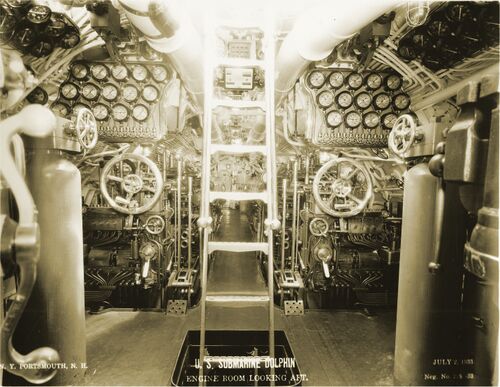Dolphin Engine Room: Difference between revisions
Pbcjohnston (talk | contribs) Created and formatted engine room |
Pbcjohnston (talk | contribs) Added photos |
||
| Line 1: | Line 1: | ||
[[File:Header 169.jpg]] | [[File:Header 169.jpg]] | ||
=== | === Engine Room === | ||
[[File]] | [[File:Dolphin Engine Rm-1.jpg|left|500px]] | ||
<div style="text-align: justify;"><span style="color:#00008B"> | <div style="text-align: justify;"><span style="color:#00008B">The engine room, looking aft from the forward bulkhead. The first thing you see on either side of the photo, left and right, are the diesel air starting flasks. High pressure air was used to roll the engines over until compression causes fuel to ignite. | ||
Second thing is the ladder from the deck access hatch passes through an opening into the lower engine room. Unfortunately, there are no photos of this lower engine room to allow us to know what was in this space. | |||
The next thing that becomes apparent is the forward faces of the two huge MAN diesels. These engines were license built MAN derivatives, with six cylinders running on a four stroke cycle. They were rated at 1,750 hp. These are direct drive engines, in that the crankshaft is connected directly to the propeller shaft through a clutch. The large wheels are most likely the throttles for increasing and decreasing the engine speeds. The gauges give vital information into the performance of all the cylinders and pressures. | |||
Flanking the ladder, at the front of the engines, are two large clutch handles for engaging and disengaging the shafts from the engines. Note the angled foot plates for the Motor Machinist Mates (later to become Enginemen) to brace a foot against to gain the leverage needed to pull the levers. | |||
Seen through the rungs of the ladder are the engine air inlet and exhaust outlet open/shut indicators, plus shaft RPM counters. | |||
<small>US Navy Photo Contributed by Roger Torgeson</small> | |||
[[File:Red bar sub new 2.jpg]] | |||
[[File:Dolphin Engine Rm-1b.jpg|left|500px]] | |||
<div style="text-align: justify;"><span style="color:#00008B">A close up of the photo above, showing detail of the rest of the engine room. The large clutch levers are on either side of the ladder. At the far end of the room is the watertight door to the maneuvering room. | |||
<small>US Navy Photo Contributed by Roger Torgeson</small> | |||
[[File:Red bar sub new 2.jpg]] | [[File:Red bar sub new 2.jpg]] | ||
Revision as of 16:09, 19 June 2023
Engine Room

Second thing is the ladder from the deck access hatch passes through an opening into the lower engine room. Unfortunately, there are no photos of this lower engine room to allow us to know what was in this space.
The next thing that becomes apparent is the forward faces of the two huge MAN diesels. These engines were license built MAN derivatives, with six cylinders running on a four stroke cycle. They were rated at 1,750 hp. These are direct drive engines, in that the crankshaft is connected directly to the propeller shaft through a clutch. The large wheels are most likely the throttles for increasing and decreasing the engine speeds. The gauges give vital information into the performance of all the cylinders and pressures.
Flanking the ladder, at the front of the engines, are two large clutch handles for engaging and disengaging the shafts from the engines. Note the angled foot plates for the Motor Machinist Mates (later to become Enginemen) to brace a foot against to gain the leverage needed to pull the levers.
Seen through the rungs of the ladder are the engine air inlet and exhaust outlet open/shut indicators, plus shaft RPM counters.
US Navy Photo Contributed by Roger Torgeson

US Navy Photo Contributed by Roger Torgeson
Page created by:
Ric Hedman & David Johnston
1999 - 2023 - PigBoats.COM©
Mountlake Terrace, WA, Norfolk, VA
webmaster at pigboats dot com
